Gerbera Daisy is a beautiful, delicate flower perfect for growing in your garden. They come in all colors and textures, and their blooms look like delicate snowflakes. They are easy to grow, attractive, and provide year-round beauty. Depending on the variety, Daisies can be brightly colored with many flowers. Growing Daisies from seed is a great way to start gardening and allows you to choose from various colorful blooms.
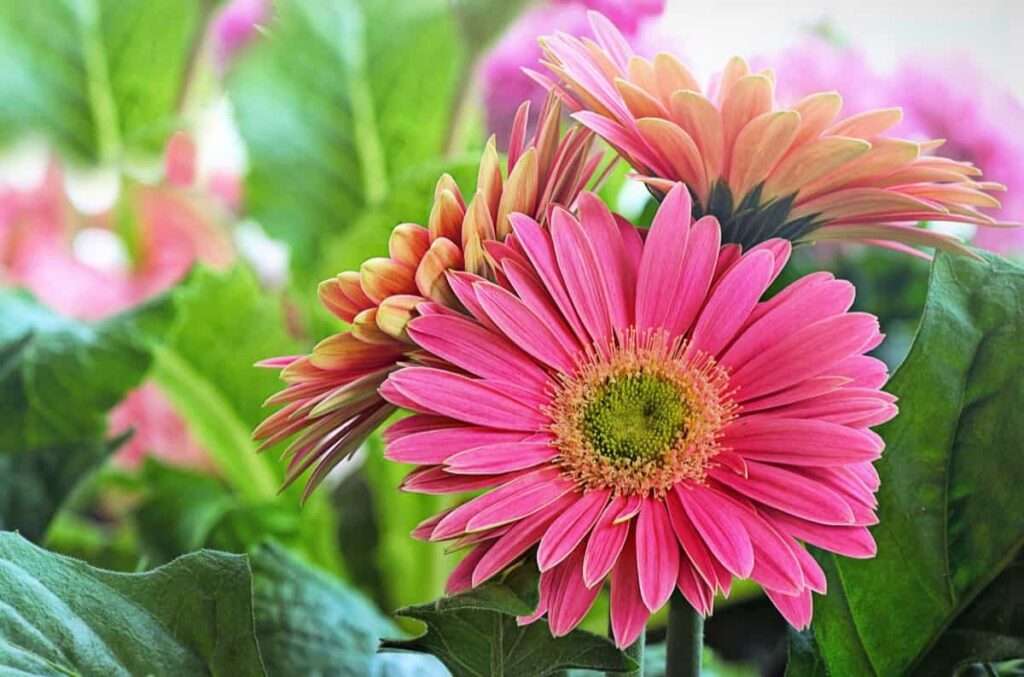
Before starting your Daisy Garden from seed, selecting a suitable variety for your region and climate is essential. There are many benefits to growing Daisies from seed. First, they are easy to grow. Second, their blooms are very fragrant. Third, they can be grown in various climates and soil types. Fourth, they produce large amounts of seedlings which can be used for planting other plants. Finally, Daisies are resistant to many common garden pests and diseases.
How to grow Gerbera Daisies from seed
How long does it take to grow Gerbera Daisy from seeds?
Gerbera Daisy is a popular garden flower that can be grown from seed. It takes 14 to 28 weeks to grow the plant from seed to harvest. If you are growing Daisies in containers, the time frame will be slightly shorter, typically around 40 to 45 days. It usually takes eight weeks to grow a seedling into an adult plant. Once the Gerbera Daisy has reached maturity, it will produce flowers for approximately six months.
Tips for harvesting seeds from Gerbera Daisies
Growing Gerbera Daisies from seed begin by sowing the seeds in a potting soil mix. After germination, the seedlings need to be transplanted into individual pots. Gerbera Daisy seeds can be harvested and dried to store for later use. To harvest the seeds, first cut off the stem of the flower. Then, use a sharp knife to cut out the seed pods from the flowers carefully. Be sure to save all of the pod shells. Once the pods are removed, dry them in a sunny location for several days. Once they are dried, store them in a sealed container for up to two years.
How do you harvest Gerbera Daisies?
Harvesting Gerbera Daisies is a simple process that can be done any time of the year. The best time to harvest the Gerbera Daisy flowers is in early summer when the petals are fully opened and the Daisy heads are full of bright yellow flowers. To harvest Gerbera Daisies, make a small cut near the base of the stem. This will prevent the flowers from turning brown and wilting. Then, use your fingers to pull each flower out of the branch gently. Be sure to leave some stems attached to the flowers.
In case you missed it: Growth Stages of Flowering Plants: Rose, Marigold, Hibiscus, Dahlia, Gerbera Daisy, and Jasmine
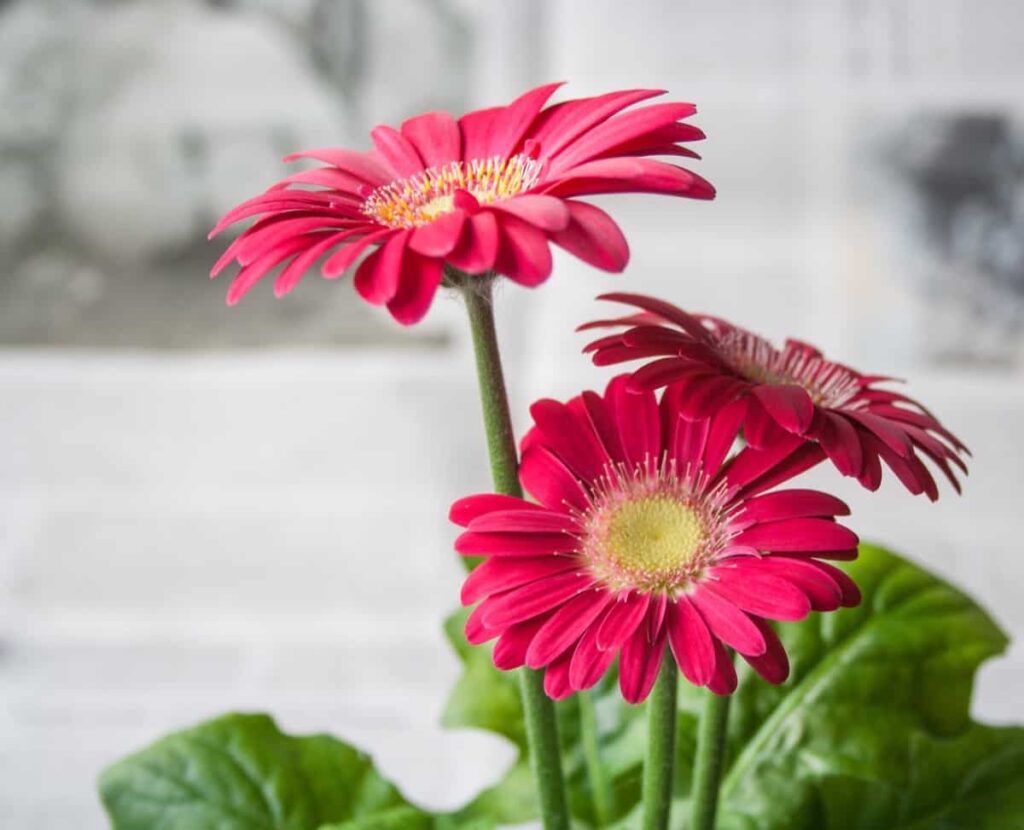
Growing Gerbera Daisy in pots
There are several varieties of Gerbera Daisies that are suitable for different climates. Gerbera Daisies are perennial flowers that can be grown from seed to harvest. They do well in pots and enjoy full sun or partial shade. Gerbera Daisy seeds should be planted in a pot in early spring and kept warm until they germinate, which typically takes about three weeks.
Once the seeds have germinated, you can move them into a sunny spot and water them regularly. Gerbera Daisy plants will reach maturity in late summer or early fall, at which point they will need to be cut back by half to promote blooming again. Harvesting the flowers is easy: snip them off close to the ground with scissors.
How many times does a Gerbera Daisy bloom?
Gerbera Daisy flowers will typically bloom four or five times over a season. After flowering, the petals will fall off, and the stem will turn brown. The first time it blooms is usually the largest, and subsequent blooms are smaller.
Sun requirement for growing Gerbera Daisies
To grow Daisies from seed, you will need to provide sufficient sunlight. Daisies require at least six hours of direct sun per day. If growing in containers, give them enough depth so they are not sitting in water or soil. Place the container in a location that receives ample sunlight throughout the day. Water the plants regularly and fertilize them, when necessary, with a balanced fertilizer diluted to 1/4 strength.
Should I deadhead Gerbera Daisies?
Gerbera Daisies are delicate flowers that grow in various colors, from bright blues to deep purples. As with most flowers, regular deadheading will help keep your Gerbera Daisy looking its best. When the blooms are ready, remove them by hand or using a scissors-type tool. Harvesting flowers is typically done when they reach their mature size; usually, this will take around six weeks for standard-sized flowers and up to ten weeks for giant blooms. Enjoy your fresh crop of Gerbera Daisies.
Gerbera Daisies winter care
Ensure your Gerbera Daisy has proper cold hardiness; if it doesn’t, you will likely have to bring it inside before the temperatures drop too low. Be prepared to water your plant regularly; most growers recommend watering them every day or two during the winter. Make sure your Gerbera Daisy gets plenty of sunlight in the winter.
It needs at least six hours of daylight Daily to stay healthy and produce flowers. Ensure the soil around the plant is well-drained so water doesn’t get trapped, and fertilize every two weeks with a high-nitrogen fertilizer. Finally, wrap the stem gently in plastic wrap or a layer of old newspaper before placing it in a garage.
In case you missed it: Best Fertilizer for Gerbera Daisy: Homemade, Organic, NPK, and Compost Manure
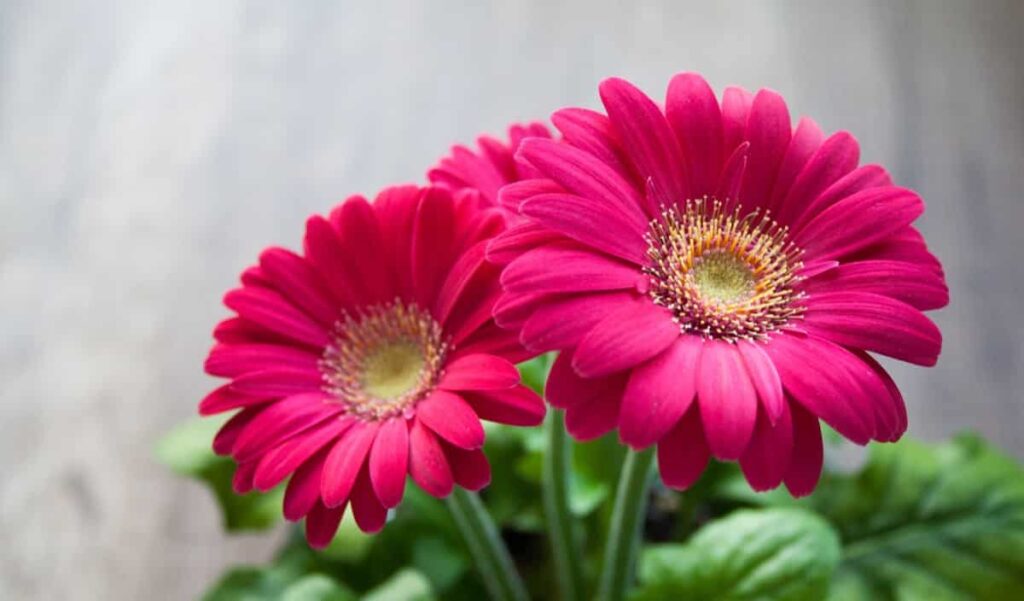
Pruning for Gerbera Daisies
- Pruning is one of the most important steps in cultivating plants, and it’s also essential for Gerbera Daisies. By pruning, you can keep your plant looking healthy and attractive while ensuring it produces the best flowers possible. Start by cutting off any dead or unhealthy leaves. This includes brown or wilted leaves and branches too tall or heavy for the plant to support.
- If you want to increase your flower yield, you may also want to prune off some taller stems that aren’t necessary for production. However, make sure not to go too far. Removing too many branches can cause your plant to become sparse and lanky in appearance.
Water requirement for growing Gerbera Daisies
- If you are looking for a pretty, easy-to-grow flower, consider growing Gerbera Daisies. These flowers need regular water but only moderate care. Gerbera Daisy plants require regular watering during the growing season, but only if the soil is dry. If your soil is wet, do not water the plants. When watering, give the plants enough water to moisten the surface of the soil but do not over-water. Over-watering can cause root rot and may also cause the plant to topple over.
- When planting Gerbera Daisy seeds in the ground or containers, mix 1/4 cup water with 1/4 cup organic fertilizer (like 20-20-20). Watering frequency should be determined by how much rainfall your area receives each month. If your site gets 10 inches of rain per month, water your Gerbera Daisy plants once a week. If your area receives less than 10 inches of rain per month, water them every other day or every three days, depending on how fast the roots absorb water.
- Watering can be tricky when growing Gerbera Daisies from seed to harvest, as they are prone to overwatering. For best results, water the plants regularly but only when the soil is really dry. Gerbera Daisy seeds will not grow in wet soil, so keep a close eye on their progress.
Why are my Gerberas not flowering?
- Gerberas may not be flowering for many reasons, but the most common reason is that plants need more light. To get your Gerberas flowering, ensure they have at least six hours of direct sunlight per day. You can also try moving the plants to a sunnier spot or adding supplemental light, such as fluorescent bulbs.
- The first thing to check is the soil. If it is not rich in organic matter, the plants may not be able to obtain the nutrients they need to grow and flower. If the plants get plenty of light but no water, they will probably not blossom. Water them thoroughly every week or so and give them plenty of sunlight.
In case you missed it: Growing Gerbera Daisy in Pots – a Full Guide

Tips for keeping your Gerberas flowering
- Water them thoroughly, using a thorough watering can. Another is to fertilize them with a weak solution of regular plant food or fish emulsion once a month. Finally, be sure to deadhead the flowers several times during the blooming period to prevent the flowers from becoming too large and producing seeds prematurely.
- Gerbera Daisy grows well in full sun to partial shade and tolerates various soil conditions, including dry and wet sites. You should thin the seedlings to 12 inches apart when they are 4 to 6 inches tall; allow them to mature into a dense multi-branched shrub 12 to 18 inches tall. Feed your Gerbera Daisy with water and fertilizer as necessary throughout the growing season; avoid over-fertilizing, as this will result in lush but unattractive plants.
The best fertilizer for growing Gerbera Daisies
- Many different types of fertilizer can be used to grow Gerbera Daisies from seed to harvest. The best fertilizer for gerberas will depend on the climate where you live and the type of soil that you have. Different fertilizers will work better for different kinds of soils.
- Peat moss is a good choice if you have heavy or clay soils. It helps improve the texture and drainage of your soil, which is necessary for growing flowers. Fish emulsion is suitable for all soil types but works especially well in sandy soils. Dolomite is a mineral that helps improve the structure and fertility of your soil. It’s a common choice for gardeners who want to grow flowers in dry climates. Different fertilizers can be used to grow Gerbera Daisies from seed to harvest. Reading the fertilizer’s label before using it is essential to ensure that the ingredients are compatible with your garden soil and plants.
When to sow Gerbera seeds in India?
Generally, Daisy seeds should be planted in early spring (March through May) in most areas. The best time to sow gerbera seeds in India is early summer, usually around late May/early June. However, depending on the weather conditions in your region, sowing may need to be delayed by a few weeks. Make sure you follow the specific planting instructions provided with the seed packet. Gerbera Daisies are hardy annuals that can tolerate dry soil and partial shade.
Growing Daisies from cuttings
Some tips for starting Daisy cuttings outdoors: Choose sturdy, disease-resistant plants that have rosettes of upright leaves and flowers. Cut off a 4-inch-long stem with fresh, green leaves and roots attached using a sharp knife. Make three parallel cuts about 1 inch apart down the stem using an even stroke, being careful not to split the stem apart. Place the cutting in water that is just below room temperature. Replace the water every 12 hours until roots develop and new shoots emerge.
The best soil for growing Gerbera Daisies
- Gerbera Daisy is a favorite flower of many gardeners. It is easy to grow from seed and can be grown in many soils, but it prefers moist soil that drains well. Gerberas like full sun or partial shade to grow well.
- If you’re looking to grow Gerbera Daisies from seed, your soil mix should be composed of a 50/50 mix of organic and mineral soil. This will help give the plants the nutrients they need to grow and provide a consistent texture. Gerbera Daisy plants prefer full sun but can tolerate partial shade as well. Remember that they are heavy feeders, so make sure to fertilize them regularly with a high-quality fertilizer designed for garden plants.
In case you missed it: Growing Hydroponic Gerbera Daisy – A Full Guide
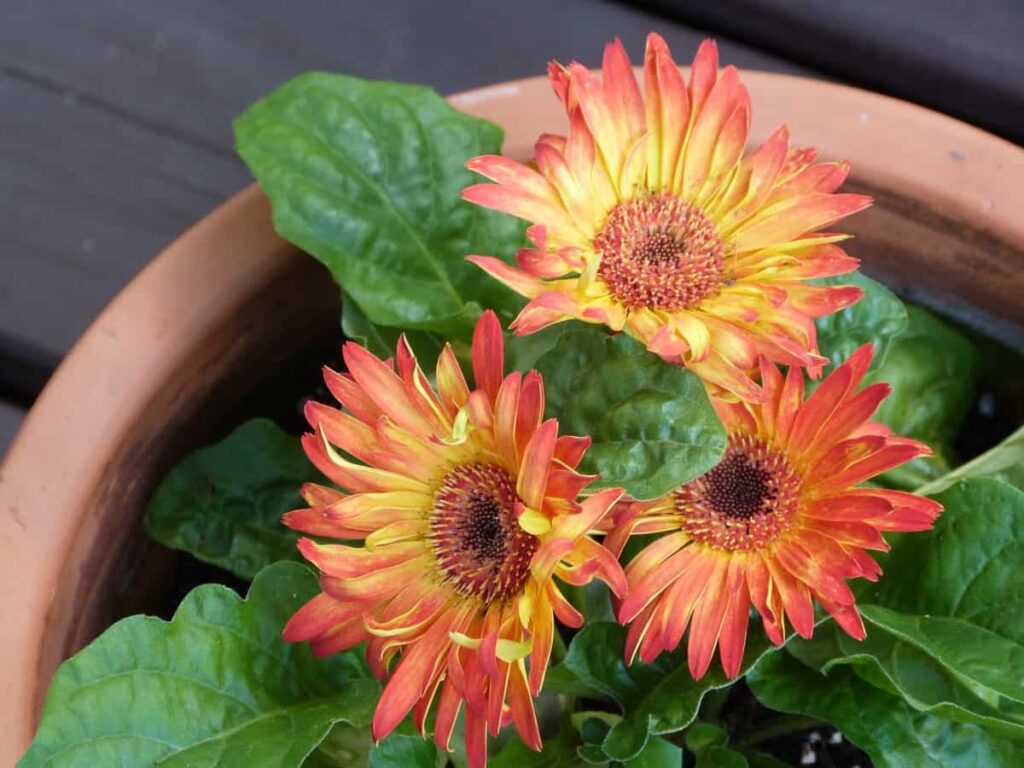
How to plant Daisy seeds?
- There are many ways to grow Daisy flowers from seed, but the simplest and most effective is by sowing them directly in the ground. Germination will take around 14 days, so keep an eye on them. Gerbera Daisy seeds should be planted ¼ inches deep and 2 inches apart. You can wait until early spring to transplant your gerbera Daisy seedlings into their permanent home or direct-seeding them in late winter or early spring after the last frost has passed.
- Water your gerberas regularly, and fertilize them during the growing season with a water-soluble fertilizer like 10-10-10. Once they’ve germinated, water them regularly and divide the plants evenly into three or four groups when they reach around 12 inches tall. Give each group plenty of space, as Daisies flowers can become weedy if crowded.
Daisy seed germination indoors
- Daisy seeds are a great option if you want to start growing flowers from seed. Daisies are perennial flowers that can be grown from seed in most climates, and they make great additions to any garden. There are several ways to germinate Daisy seeds; your chosen method will depend on your environment.
- Once you have your seeds, you will need to soak them overnight in water to soften them. After softening the seeds, you can sow them into the soil using a trowel or a garden rake. Gerbera Daisy seeds take three weeks to germinate. Once the plants have roots sprouting out, you can begin watering them regularly and fertilizing them once every other week with a fertilizer specifically for Daisies.
In case you missed it: Plant Pests and Diseases Identification: Symptoms, Causes, and Control Methods
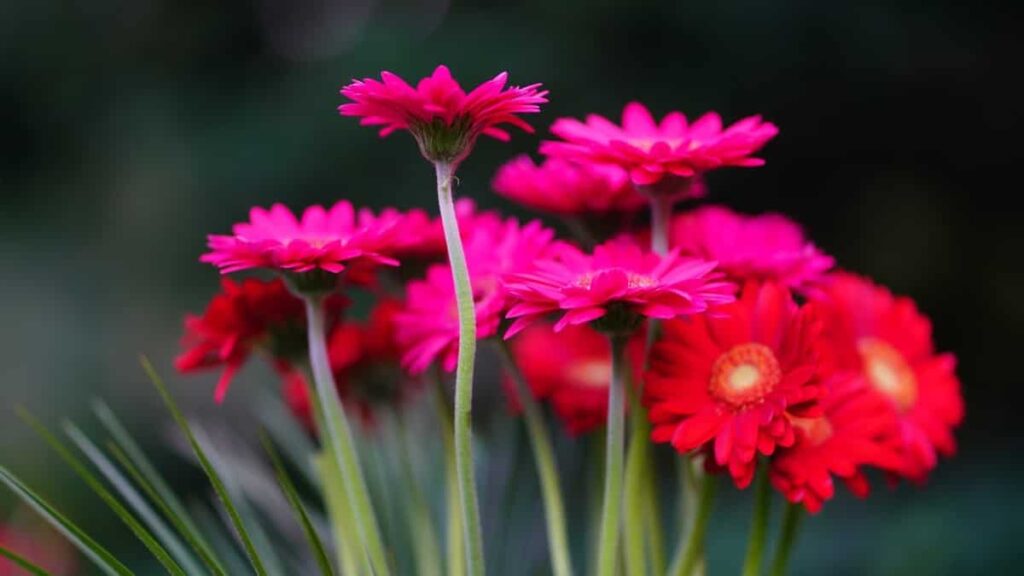
Tips for protecting Daisies from bugs and diseases
- Daisies are a great addition to any garden. They are easy to grow and require very little maintenance. However, Daisies can be susceptible to bugs and diseases, so protecting them from these pests and diseases is essential.
- One way to protect Daisies from bugs and disease is to use a bug repellent when plants bloom. You can also spray the plants with a fungicide when they show illness or infection. When planting Daisies, ensure the soil is well-drained and amend the soil with compost if necessary.
Conclusion
Daisy is a popular garden flower that many people enjoy growing. Daisies are easy to grow but require some attention to produce flowers reliably. These easy-to-grow flowers require little care and are great for filling in small spaces in your garden. Before planting, follow the instructions included with your seed packet to ensure success. Once they’ve grown, enjoy watching these beautiful flowers bloom throughout the summer.
- How to Grow Hibiscus from Flower
- Plantation Ideas for Home Decoration: A Beginners Guide
- Flower Garden Designs and Layouts for Beginners
- Planting and Spacing Techniques in Papaya: A Beginner’s Guide
- Growing Gold: Essential Techniques for Planting Pineapples
- How to Make Kalanchoe Plant Bushy: Home Remedies and Solutions
- 11 Reasons Why Your Gardenia is Not Blooming: Home Remedies and Solutions
- Eco Elegance: The Guide to Designing a Drought-Tolerant Landscape
- Gardening on a Slope: Strategies for Hillside Landscaping
- Nourish and Flourish: Top Organic Mulches for Thriving House Plants
- Everything You Want to Know about Indian Mogra Flower: Discover Uses and Growing
- Green Thumb Success: Expert Tips for Cultivating Greenhouse Pumpkins All Year Round
- Maximize Growth & Flavor: The Ultimate Guide to Companion Planting in Herb Gardens
- How to Control Rhododendron Problems Naturally: Home Remedies and Organic Ways to Fix Them
- Natural Magic: The Remarkable Benefits of Cinnamon for Plants
- Best Steps to Revive Dying Tulip with Natural and Organic Treatment
- 10 Reasons Why Your Angel Trumpet is Not Blooming: Remedies and Treatment
- How to Fix Periwinkle Leaf and Flower-Related Problems: Natural Remedies and Solutions
- How to Fix Zinnias Leaf and Flower Problems: Discover Natural and Home Remedies
- Organic Steps to Induce Lemon Tree Flowers: A Comprehensive Guide
- Bloom Booster: Crafting the Perfect Homemade Bougainvillea Fertilizer
- Optimizing Growth: A Guide to Applying NPK Fertilizer for Potted Plants
- 10 Best Homemade Fertilizers for Rubber Plant: DIY Recipes and Application Method
- How to Boost Female Pumpkin Flowers: Effective Steps for More Flowers and High Yields
- Transform Your Indoor Garden: Top Benefits of Pink Salt for Houseplants
- 10 Best Homemade Fertilizers for Peacock Plants (Calathea): Easy DIY Guide
- Unlock Blooms: 9 Reasons Why Your Potted Chrysanthemum is Not Blooming
- 8 Reasons Why Your Potted Hibiscus is Not Blooming: Fix it with Simple Solutions
- Unlock Blooms: 9 Key Reasons Your Potted Frangipani Won’t Flower
- 10 Reasons Why Is My Ice Plant Not Blooming: Remedies and Treatment
- 10 Reasons Why My Potted Hydrangea Not Blooming: Treatment and Remedies
- 10 Reasons Why is My Wisteria Not Blooming: Remedies and Treatment
- 10 Reasons Why is My Goldfish Plant Not Blooming: Remedies and Treatment
- Maximize Your Space: Ultimate Guide to Balcony Gardening with Grow Bags
- 10 Reasons Why Your Iris is Not Blooming: Remedies and Treatment
- 10 Reasons Why Your Anthurium Plant is Not Blooming: Treatment and Remedies